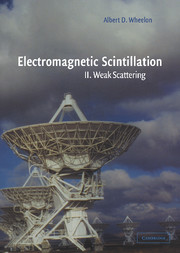Book contents
- Frontmatter
- Contents
- Preface
- 1 Introduction
- 2 The Rytov Approximation
- 3 Amplitude Variance
- 4 Spatial Covariance
- 5 The Power Spectrum and Autocorrelation
- 6 Frequency Correlations
- 7 Phase Fluctuations
- 8 Double Scattering
- 9 Field-strength Moments
- 10 Amplitude Distributions
- 11 Changes in Polarization
- 12 The Validity of the Rytov Approximation
- Appendix A Glossary of Symbols
- Appendix B Integrals of Elementary Functions
- Appendix C Integrals of Gaussian Functions
- Appendix D Bessel Functions
- Appendix E Probability Distributions
- Appendix F Delta Functions
- Appendix G Kummer Functions
- Appendix H Hypergeometric Functions
- Appendix I Aperture Averaging
- Appendix J Vector Relations
- Appendix K The Gamma Function
- Appendix L Green's Function
- Appendix M The Method of Cumulant Analysis
- Appendix N Diffraction Integrals
- Appendix O Feynman Formulas
- Author Index
- Subject Index
10 - Amplitude Distributions
Published online by Cambridge University Press: 15 December 2009
- Frontmatter
- Contents
- Preface
- 1 Introduction
- 2 The Rytov Approximation
- 3 Amplitude Variance
- 4 Spatial Covariance
- 5 The Power Spectrum and Autocorrelation
- 6 Frequency Correlations
- 7 Phase Fluctuations
- 8 Double Scattering
- 9 Field-strength Moments
- 10 Amplitude Distributions
- 11 Changes in Polarization
- 12 The Validity of the Rytov Approximation
- Appendix A Glossary of Symbols
- Appendix B Integrals of Elementary Functions
- Appendix C Integrals of Gaussian Functions
- Appendix D Bessel Functions
- Appendix E Probability Distributions
- Appendix F Delta Functions
- Appendix G Kummer Functions
- Appendix H Hypergeometric Functions
- Appendix I Aperture Averaging
- Appendix J Vector Relations
- Appendix K The Gamma Function
- Appendix L Green's Function
- Appendix M The Method of Cumulant Analysis
- Appendix N Diffraction Integrals
- Appendix O Feynman Formulas
- Author Index
- Subject Index
Summary
Predicting the distribution of measured fluctuations in intensity is one of the great challenges in describing electromagnetic propagation through random media. The amplitude variance addressed in Chapter 3 describes the width of this distribution but tells one nothing about the likelihood that very large or very small fluctuations will occur. By contrast, the probability density function for intensity variations provides a complete portrait of the signal's behavior. This wider perspective is important for engineering applications in which one must predict the complete range of signal values. The same description provides an important insight into the physics of scattering of waves by turbulent irregularities.
The Rytov approximation predicts that the distribution is log-normal. That forecast is confirmed by measurements made over a wide range of conditions on terrestrial links. It is also confirmed by astronomical observations. The agreement is independent of the model of turbulent irregularities employed. It therefore provides a test for the basic theoretical approach to electromagnetic propagation. Second-order refinements to the log-normal distribution predict a skewed log-normal distribution and agree with numerical simulations. This success represents a significant achievement for the Rytov approach.
The distribution provided by Rytov theory needs to be enlarged in some situations. It describes the short-term fluctuations observed over periods of a few minutes to a few hours. One must also consider variations of signal strength measured over weeks, months or years. Long-term statistics are important for communication services employing terrestrial or satellite relays.
- Type
- Chapter
- Information
- Electromagnetic Scintillation , pp. 316 - 358Publisher: Cambridge University PressPrint publication year: 2003



